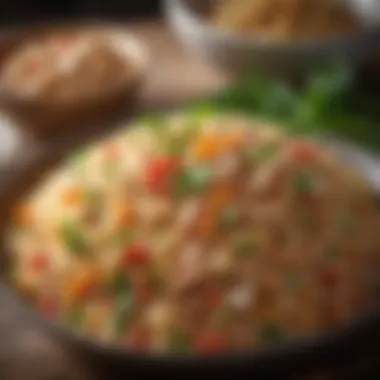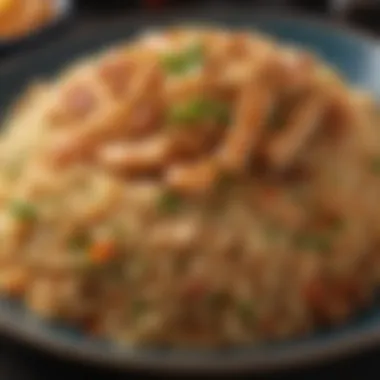Exploring the Rich Heritage of Yangzhou Fried Rice


Intro
Yangzhou fried rice is more than a simple dish; it is a showcase of culinary artistry from the Jiangsu province of China. This dish has deep roots in Chinese history, often associated with the opulent lifestyles of the Yangzhou elite during the Ming and Qing Dynasties. As such, mastering this recipe can offer not only a delightful meal but also a glimpse into the cultural tapestry that shapes Chinese cuisine today. Its balance of flavors and textures presents an inviting canvas for both seasoned cooks and novice chefs.
The dish typically features a combination of rice, meats, and vegetables, all stir-fried together to create a harmonious blend that satisfies both the appetite and the palate. By understanding the nuances of Yangzhou fried rice—the key ingredients, preparation methods, and cultural significance—you can elevate your culinary skills while honoring this iconic dish.
Recipe Overview
Brief Summary of the Recipe
Yangzhou fried rice is known for its vibrant colors and mix of ingredients, which may vary from one household to another. The dish is often characterized by its distinct combination of shrimp, ham, and an assortment of fresh vegetables, all enveloped in fried rice. A hallmark of this recipe is the use of day-old rice, as it tends to be less sticky, making it easier to achieve the desired texture.
Key Ingredients and Tools Needed
Creating this dish requires a specific set of ingredients and kitchen tools for optimal results. Here are the essentials:
- Key Ingredients:
- Tools Needed:
- Day-old rice: This is crucial for achieving fluffy rice grains. Freshly cooked rice may clump together.
- Shrimp: Adds protein and a subtle sweet flavor.
- Ham: Typically Chinese cured ham enhances the dish’s richness.
- Carrots: For crunch and sweetness.
- Green peas: They contribute color and freshness.
- Eggs: For a creamy texture and flavor.
- Spring onions: They provide a mild onion taste and garnish.
- Soy sauce: This is essential for seasoning the dish.
- Wok: A wide surface is ideal for stir-frying ingredients quickly.
- Spatula: For tossing the ingredients evenly.
- Measuring cups & spoons: To ensure the right proportions.
- Knife: For chopping vegetables and proteins.
Keeping these ingredients and tools handy will greatly facilitate the cooking process, allowing chefs to focus on maximizing flavor and achieving the perfect texture.
"Mastering Yangzhou fried rice is about more than just technique; it’s about appreciating the blend of cultures and traditions in Chinese cuisine."
Next, we will cover the detailed cooking steps that will guide you through creating this classic dish.
Prelims to Yangzhou Fried Rice
Yangzhou Fried Rice, a dish synonymous with Chinese culinary traditions, holds significant relevance not only in its city of origin but across the globe. This dish exemplifies the art of wok cooking, where each ingredient plays a critical role in achieving a well-balanced plate. Understanding Yangzhou Fried Rice goes beyond just knowing a recipe; it opens a window into the culture, history, and flavors of China.
The importance of this dish lies in its unique composition and intricate preparation process. Traditionally, it combines day-old rice with assorted vegetables, proteins like shrimp and ham, and a judicious mix of seasonings. This makes it a perfect example of how simple ingredients can transform into an exquisite culinary experience.
Moreover, Yangzhou Fried Rice stands out for its harmony of flavors and textures. When executed properly, the dish is both savory and delightful, appealing to a wide array of palates—making it an excellent showcase for both novice cooks and seasoned chefs.
In this article, we aim to delve deeper into the numerous facets of Yangzhou Fried Rice. This includes its origins, preparation methods, and variations tailored to modern preferences. Each aspect contributes to a broader understanding of this dish, allowing readers to appreciate its place within Chinese cuisine.
For those looking to master Yangzhou Fried Rice, it is essential to grasp its historical context and key elements involved in the cooking process. Engaging with this culinary tradition not only enhances one's cooking skills but also cultivates a greater appreciation for the heritage embedded within the dish.
"Food is not just sustenance; it's a narrative of culture and history."
Thus, as we explore further into the subsequent sections, the aim is to equip readers with knowledge and practical insights on preparing this iconic dish. We will examine its historical background, dissect the key ingredients, and explore preparation methods that guarantee the authenticity and taste of Yangzhou Fried Rice. All of this will ultimately enrich the dining experience, whether it be at home or in a restaurant.
Historical Background
Understanding the historical context of Yangzhou Fried Rice provides the reader with a deeper appreciation of this dish. It is vital to recognize not only where it originated but also how it evolved into one of China's most beloved culinary creations. This section sheds light on the development of fried rice in China and its specific evolution in Yangzhou, a city rich in gastronomic history.
Origins of Fried Rice in China
Fried rice is not merely a dish; it represents a significant culinary practice in Chinese tradition. Its origins can be traced back to the Sui Dynasty (581-618 AD). However, it gained widespread recognition during the Tang (618-907 AD) and Song (960-1279 AD) dynasties. Early records suggest that this style of preparation aimed to utilize leftover rice and ingredients, reflecting resourcefulness in cooking. By stir-frying pre-cooked rice with assorted ingredients, the dish minimized waste while enhancing flavors. Utilizing common staples like vegetables, meats, and various seasonings, the versatility of fried rice emerged, making it an integral part of Chinese cuisine.
The simplicity of the methods, paired with the array of possible combinations, positioned fried rice as a staple across different regions in China. It was not long before it adapted to various cultural influences and local ingredients, reinforcing its place in Chinese dining culture.


Evolution of Yangzhou Fried Rice
Yangzhou Fried Rice emerged specifically from the city of Yangzhou during the Qing Dynasty (1644-1912). Its creation is often attributed to the local chefs who refined the dish into a more sophisticated version. Unlike the basic fried rice that served practicality, Yangzhou Fried Rice incorporated high-quality ingredients and refined cooking techniques, making it a delicacy renowned for its taste and presentation.
Key characteristics that define Yangzhou Fried Rice include the use of long-grain rice, often jasmine or other fragrant varieties, and a harmonious blend of ingredients. Traditional recipes call for savory proteins, such as shrimp, ham, and chicken, alongside seasonal vegetables. The choice of seasonings is also meticulous, ensuring the dish is rich and flavorful.
While maintaining its roots, the dish has constantly evolved, integrating influences from various culinary styles yet always paying homage to its origins. Today, Yangzhou Fried Rice is not just a meal but a symbol of culinary pride.
"The essence of Yangzhou Fried Rice lies not only in the ingredients but in the love for the art of cooking itself."
This evolution reflects changing societal values and culinary trends within Chinese culture, where the appreciation for food transcends mere sustenance to become an experience and an art form.
Key Ingredients
Understanding the key ingredients in Yangzhou fried rice is essential to appreciate what makes this dish not only a culinary delight but also a staple in Chinese cuisine. Each ingredient plays a crucial role in providing flavor, texture, and nutritional value. Selecting high-quality components can enhance the overall experience, making the dish more authentic and enjoyable. Moreover, the ingredients impact the cooking method, reflecting both region and tradition.
Staple Components
The foundation of any fried rice dish lies in its staple components. For Yangzhou fried rice, the primary ingredient is rice, preferably day-old rice, which is kept in the refrigerator after cooking. This aging process helps the rice grains firm up, preventing them from becoming mushy during frying. Jasmine rice is often used for its subtly fragrant aroma, offering a delightful companion to the other flavors in the dish.
Aside from rice, vegetables such as carrots, peas, and scallions are commonly included. These not only add color but also provide crunch and contrast to the softness of the rice. The inclusion of ham is traditional, providing both a savory flavor and additional texture.
Essential Seasonings
While the ingredients form the core of Yangzhou fried rice, the seasonings bring the dish to life. Soy sauce and oyster sauce are integral, providing umami and depth. It's important to use these sauces judiciously, as too much can overwhelm the dish's delicate balance. The use of sesame oil towards the end of cooking adds a distinct nuttiness that elevates the flavor profile.
Adding white pepper provides a subtle heat without dominating the dish, allowing the flavors to sing harmoniously. A touch of salt may be necessary, depending on the sodium richness of the soy sauce or other added components.
Recommended Proteins
The protein component in Yangzhou fried rice contributes not only to the flavor but also to the nutritional value of the dish. Traditionally, diced Chinese sausage, or lap Cheong, is mixed into the fried rice for its sweet and savory essence. It is generally preferred due to its unique flavor, which can be distinct from common pork or chicken.
Eggs are also a staple addition, typically scrambled and mixed throughout the rice. They provide creaminess and richness that balances the other ingredients. For those who prefer variety, a mix of proteins like shrimp or cooked chicken can also be incorporated, allowing chefs to customize the dish according to personal tastes.
Using high-quality ingredients and proper techniques can elevate a simple fried rice dish into a culinary masterpiece.
Ultimately, the careful selection and preparation of these key ingredients form the basis of an exceptional Yangzhou fried rice, ensuring an intriguing blend of flavors and textures for all who savor it.
Preparation Method
The preparation method is crucial in the context of Yangzhou fried rice. This dish is characterized by its unique combination of flavors and textures, and the cooking process significantly impacts the final outcome. Understanding this method allows cooks to master not just the recipe but also the key principles behind creating an outstanding fried rice. A well-executed preparation method leads to balanced dish where all ingredients harmonize effectively.
Importantly, timing and heat control play pivotal roles in the preparation. To achieve that ideal texture where rice grains remain separate yet coated in flavor, one must pay attention to these elements throughout the cooking stages.
Step-by-Step Cooking Instructions
- Ingredients Preparation
Before commencing, ensuring all ingredients are prepared is essential. First, the rice should ideally be a day old, as this allows for a drier texture, which prevents clumping during the frying process. - Wok Heating
Heat a wok over medium-high flame. A well-seasoned cast iron or carbon steel wok is best for this purpose. This ensures even heat distribution and an authentic flavor. - Cooking Proteins
Add oil to the heated wok and cook the proteins first. For instance, shrimp should turn pink and opaque. Remove from the wok and set aside. - Stir-Frying Vegetables
Introduce the vegetables into the wok. Stir fry them quickly to maintain crunchiness. - Incorporating Rice
Now, add the day-old rice into the wok. Using a spatula, break up any clumps while stirring vigorously. This step allows the rice to absorb flavors effectively. - Seasoning the Rice
Add the prepped seasonings gradually. Start with soy sauce for color and flavor, followed by a drizzle of sesame oil for richness. Stir well to combine. - Combining Everything
Finally, return the cooked proteins to the wok, mixing everything thoroughly until evenly distributed and heated through. - Final Touches
A sprinkle of chopped scallions can be added right before serving for freshness.
- Chopped vegetables: carrots, peas, and scallions.
- Proteins: shrimp, chicken, or eggs. Choose according to personal preference.
- Seasonings: soy sauce, sesame oil, and white pepper.
- The goal is to just soften them without losing vibrant colors.
Cooking Techniques


Using the right cooking techniques is key to achieving the best Yangzhou fried rice. Here are a few crucial methods to keep in mind:
- High Heat Stir Frying: This technique ensures quick cooking while sealing in flavors. The high temperature helps to achieve a slight char on the ingredients.
- Ingredient Sequencing: Cooking ingredients in stages is vital. Proteins are cooked first, followed by vegetables, and lastly, the rice. This method allows each component to maintain its designated texture and flavor profile.
- Tossing and Folding: Utilize an up-and-down motion as you stir-fry. This technique promotes even cooking while preventing any one side of the rice from overcooking.
Utilizing these methods and instructions will lead to a delightful Yangzhou fried rice, delighting any food lover with authentic taste and texture.
Common Variations
Variety in food is essential for engagement and satisfying diverse palates. Yangzhou fried rice is no exception. The common variations of this dish speak not just to its flexibility but also to the culinary creativity prevalent in different cultures and personal preferences. Adapting the traditional recipe can lead to exciting results, bringing unique flavors to the forefront while still keeping the essence of the dish.
Vegetarian Options
For those who prefer vegetarian meals, adapting Yangzhou fried rice is quite straightforward. Eliminating meat can be done without sacrificing flavor.
Some common ingredients used for vegetarian versions include:
- Tofu: Grilled or stir-fried tofu serves as an excellent protein source.
- Mixed Vegetables: Ingredients like carrots, peas, bell peppers, and broccoli not only enhance the dish’s colors but also its nutritional value.
- Eggs: While not completely vegan, scrambled eggs can be added for richness and a boost of protein.
The use of soy sauce and sesame oil contributes rich, savory tastes, ensuring that vegetarians will enjoy a delectable dish. Overall, vegetarian options encourage inclusivity in dining without compromising on satisfaction.
Vegan Adaptations
Transitioning to a vegan version of Yangzhou fried rice requires careful selection of ingredients to maintain both flavor and nutrition. The aim is to create a satisfying meal that caters to those avoiding animal products entirely.
Popular substitutions include:
- Plant-based Proteins: Seitan or tempeh can step in for traditional proteins. They offer a chewy texture and absorb flavors well.
- Nutritional Yeast: Used to provide a deeper umami quality, it can also add a creamy texture when mixed in.
- Vegan Egg Replacements: Products like chickpea flour can be used to create a scrambled-egg-like texture.
This variation of Yangzhou fried rice not only respects vegan principles but also expands the flavor profile, making the dish enjoyable for a broader audience.
Fusion Styles
As with many traditional dishes, fusion styles of Yangzhou fried rice create opportunities for innovation. Cooks can infuse elements from different cuisines, allowing for unique combinations that can attract a diverse crowd.
Some fusion ideas might include:
- Mexican Influence: Incorporating ingredients like black beans, corn, and jalapeños, with a touch of cumin or chili powder, adds a distinct twist.
- Indian Spices: Mixing in spices such as garam masala or turmeric can bring warmth and complexity to the dish.
- Mediterranean Ingredients: Incorporating olives, sun-dried tomatoes, or feta cheese creates a bright flavor profile, setting it apart from the original dish.
These fusion styles not only reflect personal culinary preferences but also highlight the global popularity of fried rice. Each variation reveals the dish’s versatility and capacity for reinvention, making it relevant across different cultures and tastes.
Nutritional Information
Nutritional information serves as a vital aspect when discussing any dish, including Yangzhou Fried Rice. This type of analysis offers insights into the health benefits and potential drawbacks of this beloved meal. Understanding the nutritional profile helps consumers make informed decisions about their diet. It is essential to look at both caloric content and dietary considerations. Knowing these elements helps appreciate how Yangzhou Fried Rice can fit into a balanced diet.
Caloric Content
The caloric content of Yangzhou Fried Rice is influenced by its ingredients and portion size. On average, a serving can range between 400 to 600 calories. However, this variation largely depends on the protein and oil quantity used in the preparation. For example, adding more eggs or pork increases the caloric load significantly. To maintain a healthy intake, it is crucial to manage portion sizes and opt for leaner proteins when possible.
Understanding the caloric content helps in making conscious dietary choices when enjoying this dish.
It's worth noting that fried rice can be quite filling due to its carbohydrate base combined with various proteins. For those watching their calorie intake, utilizing brown rice can be an excellent alternative. Brown rice is higher in fiber and can aid in digestion, thus positively contributing to the overall nutritional value.
Dietary Considerations


Several dietary considerations are essential when preparing Yangzhou Fried Rice. For individuals with dietary restrictions, adapting the recipe is particularly relevant. Here are key elements to consider:
- Gluten-Free Options: For those with gluten sensitivity, using tamari instead of soy sauce can provide flavor without the gluten.
- Lower Sodium Alternatives: Individuals monitoring sodium intake can choose low-sodium soy sauce and control seasoning proportions.
- Allergen Awareness: Some may be allergic to shellfish or specific proteins often found in fried rice dishes. It is crucial to customize the dish according to personal health needs.
- Dietary Preferences: Vegans and vegetarians can replace traditional proteins with tofu or tempeh and still derive enjoyment from the dish.
It's important to remember that while Yangzhou Fried Rice offers a flavorful experience, it should also align with personal health goals, such as maintaining energy levels and supporting overall well-being. Making informed choices about the ingredients leads to a healthier eating experience.
Cultural Significance
Understanding the cultural significance of Yangzhou fried rice offers insight into not only a beloved dish but also the broader scope of Chinese culinary traditions. This dish serves as more than sustenance; it is steeped in history and reflects the values of togetherness and communal dining in Chinese culture. In many households and restaurants across China, Yangzhou fried rice is not just a meal but a celebration of family, festivals, and social gatherings.
Role in Chinese Cuisine
Yangzhou fried rice is a pivotal dish in Chinese cuisine. Often considered a staple, its origins can be traced back to the city of Yangzhou, where it was perfected by local chefs. This dish showcases techniques that are central to Chinese cookery, such as wok frying, precise chopping, and the balancing of flavors. The fried rice embodies the principles of using seasonal ingredients, ensuring that freshness remains at the forefront of preparation. Additionally, it reflects the harmony of the five flavors: sweet, sour, bitter, spicy, and salty.
"In the realm of culinary art, each dish tells a story, and Yangzhou fried rice undoubtedly narrates the rich heritage of Chinese gastronomy."
As a dish, it operates within context; it can be found in upscale restaurants as well as street food stalls. The versatility of Yangzhou fried rice means it can cater to diverse tastes and dietary needs, further solidifying its place in the daily lives of the Chinese people.
Symbolism and Festivals
In Chinese culture, food carries symbolic meanings, and Yangzhou fried rice is no exception. It is often served during significant celebrations, such as the Lunar New Year and weddings, symbolizing prosperity and health. The act of enjoying fried rice together is a gesture that symbolizes unity and abundance.
Different versions of this dish can also reflect specific local customs and seasonal celebrations, such as those during harvest festivals. At these times, the inclusion of local ingredients gives the dish a unique character and enhances its significance.
This cultural connection not only highlights the importance of Yangzhou fried rice in culinary traditions but also emphasizes the essential role of food in fostering community bonds and cultural heritage.
Serving Suggestions
Serving suggestions are essential to elevating the experience of Yangzhou fried rice. This dish, cherished for its flavor and texture, truly shines when accompanied by appropriate complementary dishes and thoughtful presentation. Providing guidance on how to serve Yangzhou fried rice not only enhances its appeal but also offers ways to engage diners in a culinary journey.
Complementary Dishes
The choice of complementary dishes can notably enhance the overall dining experience. Yangzhou fried rice is versatile and pairs well with various items. Here are some suggestions for dishes that can complement this classic:
- Chinese Tea: A delicate green or jasmine tea can cleanse the palate and balance the dish’s richness.
- Stir-Fried Vegetables: Dishes that feature seasonal greens, such as bok choy or Chinese broccoli, can add freshness and vibrancy to the meal.
- Dumplings: Dumplings, whether steamed or pan-fried, can provide a contrasting texture and additional flavors to the dinner table.
- Soup: A light broth or wonton soup can warm up the meal and create a satisfying harmony of flavors.
- Spring Rolls: These crispy delights add crunch and can introduce varied tastes, especially if filled with vegetables or proteins.
Each of these dishes offers a unique element that can enhance the dining experience while ensuring the flavors of Yangzhou fried rice remain at the forefront.
Presentation Tips
The visual appeal of food greatly influences how it is perceived and enjoyed. Here are several tips to effectively present Yangzhou fried rice:
- Color Balance: Use vibrant ingredients to bring color to the rice. Incorporate bright peas, carrots, and egg for an inviting look.
- Garnishing: Fresh herbs, such as cilantro or green onions, can be sprinkled on top just before serving to elevate the dish visually.
- Plating Types: Consider serving the fried rice in a bowl or a white plate to provide a beautiful contrast with the colorful fried rice. A simple clean presentation can make the dish pop.
- Serving Size: Present in smaller portions that allow diners to share and appreciate different flavors throughout the meal.
- Accompaniments: Arrange complementary dishes around the Yangzhou fried rice on the table. This creates a diversified and appealing buffet-style setup.
A thoughtful presentation acknowledges the artistry of cooking and enhances the overall dining experience for your guests.
By applying these serving suggestions and presentation tips, Yangzhou fried rice can become the centerpiece of any meal, inviting appreciation and enjoyment from diners of all ages.
Closure
The conclusion serves as a crucial part of the article by summarizing the overall exploration of Yangzhou fried rice. It encapsulates the rich history, unique ingredients, and intricate preparation methods discussed throughout. By revisiting these key elements, the conclusion reinforces the depth of knowledge presented earlier and highlights the dish's significance in Chinese cuisine.
Yangzhou fried rice is not merely a popular dish. It embodies centuries of culinary tradition and cultural significance. Understanding its origins allows food enthusiasts to appreciate the layers of flavor and techniques that go into each bite. Furthermore, the dish integrates various ingredients, giving a glimpse into regional preferences and availability, thus enriching one's culinary knowledge.
In addition, the conclusion draws attention to the practicality of mastering Yangzhou fried rice. The article details various cooking tips and methods, which demystifies the cooking process for both novice and experienced cooks. Having a reliable recipe offers the benefit of creating a beloved dish at home, enhancing one’s cooking repertoire.
Also, the nutritional aspect discussed in previous sections is crucial. Being informed about the caloric content and dietary considerations encourages healthier choices in cooking, catering to diverse dietary needs. This attention to nutritional details can empower readers to make conscious decisions about their meals.
Ultimately, the conclusion emphasizes that learning to cook Yangzhou fried rice is not just about following a recipe. It is about embracing a culinary journey that connects generations of cooks and diners through shared experiences and flavors. This dish represents a delightful contribution to culinary arts, inviting everyone to explore and appreciate the nuances of its preparation and cultural importance.







